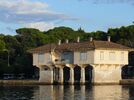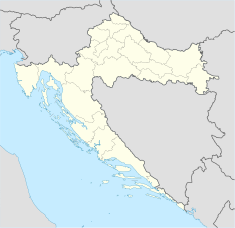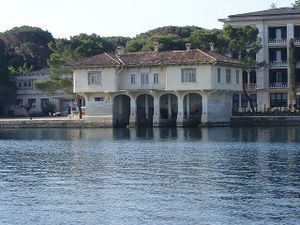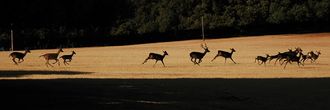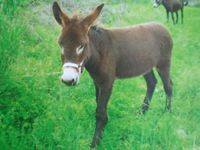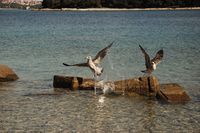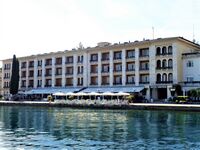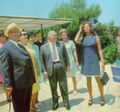بريوني
| جزر بريوني، المنتزه الوطني Brijuni Islands National Park | |
|---|---|
| الاسم المحلي Croatian: Nacionalni park Brijuni | |
Brijuni | |
| الموقع | مقاطعة إستريا، |
| الإحداثيات | 44°55′N 13°46′E / 44.917°N 13.767°E |
| المساحة | 7.5 |
| الاسم الرسمي | Nacionalni park Brijuni |
| أرخبيل | جزر بريوني |
| إجمالي الجزر | 14 |
| الجزر الكبرى | ڤلي بريون، مالي بريون |
بريوني (تـُنطق [brijǔːni]) أو جزر بريوني (وتسمى أيضاً الجزر البريونية; إيطالية: Brioni)، هي مجموعة من 14 جزيرة صغيرة في الجزء الكرواتيا من شمال البحر الأدرياتي، يفصلها عن الساحل الغربي لشبه الجزيرة الإسترية مضيق فجانا. أكبر جزرها ڤليكي بريون (تُسمى أيضاً إيطالية: Brioni Grande أو كرواتية: Veli Brijun), (5.6 كم²)، والتي تبعد 2 كم عن الساحل. ثاني أكبر جزرها هي مالي بريون وتبلغ مساحتها 1.07 كم²، وهناك اثنى عشر جزيرة أصغر. تشتعر بريوني بمناظرها الجميلة وتعتبر الجزر منتجعاً لقضاء العطلات ومنتزهاً وطنياً كرواتياً.
اكتسبت الجزر شهرة عالمية في عام 1956 خلال اجتماع بريوني عندما التقى القادة الرئيسيون لحركة عدم الانحياز، عبد الناصر ونهرو، مع المضيف، الرئيس اليوغوسلافي تيتو، لتشكيل إعلان بريوني الذي كانت بمثابة الأساس للسياسات التي ستتبعها الحركة.[1] وثمة حدث آخر وقع في الجزر، ألا وهو اتفاق بريوني في 1991.
التاريخ
The Brijuni islands were called by ancient Greeks Pollariae or Pullariae (Πολλάριαι), and later, they were called Brioniano.
The Brijuni Islands had some Ancient Roman settlements, but up to the late 19th century the islands were mainly used for their quarries, which have been worked on for centuries. The islands belonged to Venice from the Middle Ages, and stone from the islands was used to build the palaces and bridges of the city.[2] The islands were part of the Illyrian Provinces after Napoleon's brief annexation.
In 1815 the islands became part of the Austrian Empire, which later became Austria-Hungary. During this period the islands' quarries first supplied stone to Vienna and Berlin. With the erection of a naval base in the harbour of Pula, the Austrians built a strong fortress, "Fort Tegetthoff," on Veliki Brijun Island Island, together with minor fortifications on some of the others.[3]
The Austro-Hungarian Navy abandoned the fortress, and in 1894 the Viennese business magnate Paul Kupelwieser bought the whole archipelago and created an exclusive beach resort. In 1900 Kupelwieser invited Robert Koch, the renowned microbiologist, to conduct his malaria eradication experiments on Brijuni. Koch and his associates were successful, and in 1901 the island was declared malaria-free.[4]

The estate was supplemented with first class hotels, restaurants, beach resorts, a casino and a yacht harbour and became a focal point in social life on the Austrian Riviera. Kupelwieser also established a sailing regatta, a golf course and – due to the flourish of Austrian Culture – various musical concerts and literature events. The Brijuni islands became popular as a destination for the Viennese upper class and were visited by members of the Imperial family and other wealthy European bourgeois and aristocrats. During The Great War the Austro-Hungarian navy had a submarine base here.
في عام 1918 بعد الحرب العالمية الأولى أصبحت بريوني جزءاً من دولة إيطاليا. حاول كارل كوپولڤايسر، ابن مؤسس المقاطعة الحفاظ على رونقها السابق، لكن في أعقاب الأزمة الاقتصادية التي تلت انهيار وال ستريت 1929، أفلست المقاطعة حيث استحوذت عليها الحكومة الإيطالية، وظلت جزءاً من إيطاليا حتى استسلامها عام 1943.
عام 1945 بعد الحرب العالمية الثانية أصبحت بيروني جزءاً من يوغسلاڤيا وجعل الرئيس المارشال يوسيپ بروز تيتو من جزر بريوني مقراً صيفياً شخصياً له. قام المعماري السلوڤيني يوزه پلنتشنيك جناحاً لتيتو. قام ما يقارب 100 رئيس أجنبي بزيارة تيتو على جزيرته، بالإضافة لنجوم السينما ومنهم إليزابث تايلور، ريتشارد بورتون، صوفيا لورين، كالرو پونتي، جينا لولوبريجيدا. توفيى تيتو عام 1980، وبحلول 1983 أُعلنت الجزيرة منتزهاً وطنياً تابعاً ليوغسلاڤيا.
في منتصف يوليو 1956، اجتمع الرئيس المصري جمال عبد الناصر، رئيس الوزراء الهندي جواهر لال نهرو، والرئيس اليوغسلاڤي يوسيپ بروز تيتو هناك لمناقشة معارضة بلدانهم للحرب الباردة. تبلورت هذه الأفكار لاحقاً في حركة عدم الانحياز. قارن ڤيجاي پراشاد بين هذا الاجتماع وبين مؤتمر يالطا.[5]
عام 1991، نالت كرواتيا استقلالها وجعلت من جزر بريوني مركزاً للمؤتمرات الدولية (انظر اتفاقية بريوني). وأعيد افتتاح الفنادق الأربعة على جزيرة ڤليكي بريون، بالإضافة لمنتزه سفاري، الذي يضم حيوانات أهديت لتيتو، مثل سوني ولانكا، فيلين هنديين تبرعت بهما إنديرا غاندي. سوني، تُبرع به لتيتو عام 1970 وعمره سنة ونصف، وتوفي في 2010. بطولة بريوني الدولية للپولو، والتي ترجع للعهد الإيطالي النمساوي عام 1924، استؤنفت منذ 2004.
النبيت
Most of the flora on the archipelago of the Brijuni islands has the typical Mediterranean characteristics. On Veliki Brijun Island there are about 600 indigenous plant species. Here cedars, bamboos, and the pyramidal yew have become acclimatised, while on Vanga the dwarf spruce grows. There is also much exotic vegetation that Tito received from foreign statesmen.[2] The most important plant associations of Veliki Brijun Island are: Maquis shrubland, Holm Oak, and Laurel forest, and Conifers, which are very characteristic of the region.
It is interesting to point out that on the islands there are some plant species that are among the endangered plant species of Istria (marine poppy, wild cucumber, some grass species etc.), but on the islands they are quite widespread and develop freely.[بحاجة لمصدر] The most valuable part of the island from the point of view of vegetation stretches from the Villa Brijunka in the south, and the most lovely forest is found in the east of the White Villa.[بحاجة لمصدر]
الوحيش
Because of the millennial presence of men on the archipelago of Brijuni, the animal world on the islands, especially Veliki Brijun, besides the autochthonous species, was enriched by many imported species that are not congenial to this habitat but got acclimated to it thanks to the almost ideal microclimatic conditions. Inside the park there is an ethno park is an area within the Safari park presenting a typical Istrian homestead with its autochthonous animal species. Istrian ox (a descendant of the Aurochs), Istrian sheep, donkeys and goats. It is intended both as a habitat and presentation of domestic animals of Istria.
In addition, the chital deer, fallow deer and mouflons were introduced to the Veliki Brijun Island in the early 20th century.[6] Their numbers increased in the following decades and can be seen roaming freely around the island.
In the late 19th century and early 20th century the European hare, the chital, the fallow deer and the mouflon were imported, so their descendants still adorn the forests, parks and glades of Brijuni and are part of its identity.[بحاجة لمصدر] The autochthonous birds are quite well represented. Some of the smaller islands are excellent habitats where gulls and sea swallows nest, as well as some rare genera of cormorants. The Brionian islands are also important seasonal habitats of northern bird species and the most interesting is the locality of Saline. That is a very damp area with three marshy lakes of 8 acre (32،000 m2) of fenced area with the aim of forming an ornithology reservation. The biggest lake is overgrown with reed and is a good nestling ground for numerous types of birds.
On the island there is also a Safari Park, it is home to a variety of exotic animals which were given to the park as gifts from diplomatic partners. The nilgai, zebu and Asian elephant were donated as a gift from India, plains zebra and mountain zebra were given by Ahmed Sékou Touré from Guinea, waterbuck came from Ethiopia.[بحاجة لمصدر]
The local seas of the Brijuni archipelago are important hatching grounds and representative marine parks for the typical marine organisms of the northern Adriatic. Of the marine organisms that are protected by the Law on Environmental Conservation in the waters of Brijuni you can find the pen-shell and the date-shell. Sea turtles and dolphins, the protected marine vertebrates, can also from time to time be seen in the waters of Brijuni. There are also some endemic species like the black tang, Jadranski bračić, and the Tunicate, Jadranski ciganin.
The seabed abounds in sponges, shellfish, sea urchins, crustaceans, fish etc. In the past in the seas of Brijuni were found some species that were never seen in the Adriatic, as well as some species up to then unknown to scientists like the soft coral Alcyonium brionense or the variety of the sponge Ircinia variabilis fistulata.
السياحة
On the Brijuni there are several archaeological and cultural sites.
At four sites on Veliki Brijun Island over 200 dinosaur footprints have been discovered, which can be traced to the Cretaceous Period from where Brijuni Cretaceous Park gets its name.
The island encompasses several archeological sites. There is the 13th century AD St. Mary's Church which was built by the Knights Templar. There are also two ancient Roman villa remains, from the 2nd Century BC and remains of a Byzantine fort. The last remain is Hill-fort which indicates a Bronze Age settlement on the island dating back to 14th century BC.
The island houses an exhibition dedicated to Josip Broz Tito, showcasing photographs of more than a hundred state visits to the island.[1] According to an analysis of reviews, many visitors find the exhibit anachronistic or even unsettling.[1] Based on an Ethics of Political Commemoration, one author suggested that the exhibition should contain an explicit reference to Goli Otok, a nearby Adriatic island on which political prisoners were held during Tito's rule, to ensure a more balanced presentation.[1] The lower floor of the museum is dedicated to stuffed animals, derived from the island's zoo.
There are also several exhibitions including natural history and art exhibitions, and archaeological collections.
غيرها
The Italian clothing company Brioni is named after the Italian name for the islands.
James Joyce celebrated his 23rd birthday on Veliki Brijun on 2 February 1905
معرض الصور
جمال عبد الناصر، تيتو، وجواهرلال نهرو، في قمة بريوني، 1956.
تيتو مع الممثلة الإيطالية صوفيا لورين.
يوسپ بروز تيتو يحيي السيدة الأولى السابقة للولايات المتحدة إليانور روزڤلت أثناء زيارتها في يوليو 1953 إلى جزر بريوني، جمهورية كرواتيا الشعبية، جمهورية يوغسلاڤيا الشعبية الاتحادية.
Ostaci bizantskog kaštela
Spomen-ploča Robertu Kochu
Brijuni, Pula i okolica iz zraka
انظر ايضاً
المصادر
- ^ أ ب ت ث Gutbrod, Hans (October 18, 2022). "BRIJUNI OR BRIONI: REVIEWING TITO'S LUXURY ISLAND". Baltic Worlds. Retrieved 22 October 2022.
- ^ أ ب Naklada Naprijed, The Croatian Adriatic Tourist Guide, pg. 58, Zagreb (1999), ISBN 953-178-097-8
- ^ One or more of the preceding sentences incorporates text from a publication now in the public domain: Chisholm, Hugh, ed. (1911). . دائرة المعارف البريطانية. Vol. 4 (eleventh ed.). Cambridge University Press. pp. 572–573.
{{cite encyclopedia}}: Cite has empty unknown parameter:|coauthors=(help) - ^ "Kupelwieser, Paul". Istrapedia (in الكرواتية). Retrieved 9 January 2016.
- ^ Vijay Prashad, The Darker Nations: A People's History of the Third World. New York: The New Press, 2007. Page 95.
- ^ "Životinje u slobodnoj prirodi" (in الكرواتية). Brijuni National Park. Archived from the original on 29 March 2007. Retrieved 16 June 2010.
وصلات خارجية
- Pages using gadget WikiMiniAtlas
- مقالات المعرفة المحتوية على معلومات من دائرة المعارف البريطانية طبعة 1911
- Wikipedia articles incorporating text from the 1911 Encyclopædia Britannica
- CS1 الكرواتية-language sources (hr)
- Short description is different from Wikidata
- Coordinates on Wikidata
- Pages using infobox historic site with unknown parameters
- Articles containing إيطالية-language text
- Pages using Lang-xx templates
- Articles containing كرواتية-language text
- مقالات ذات عبارات بحاجة لمصادر
- جزر البحر الأدرياتي
- جزر كرواتيا
- مناطق محمية في مقاطعة إستريا
- تضاريس مقاطعة إستريا
- منتزهات وطنية في كرواتيا
